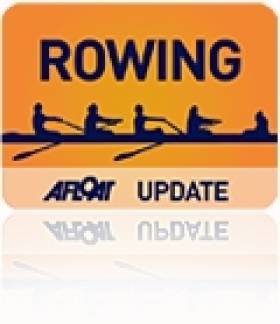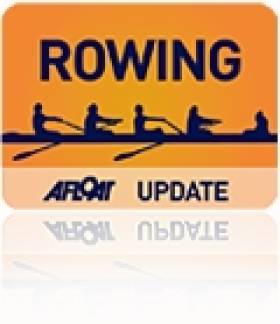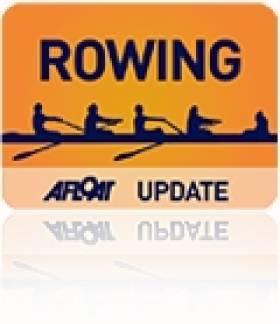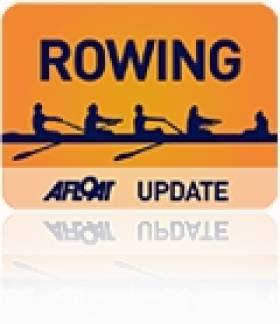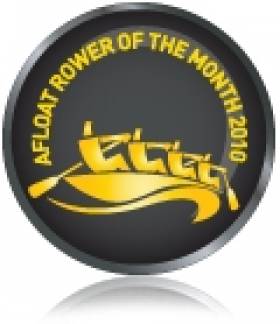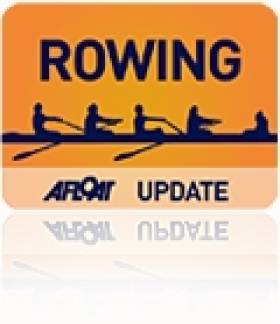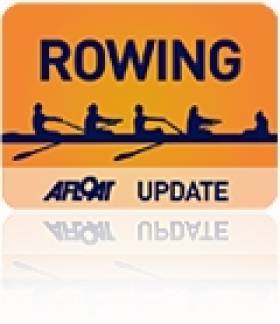Displaying items by tag: rowing
UCD's Senior Eight Fastest at Neptune Head of the River
UCD’s men’s senior eight were by far the fastest crew at the Neptune Head of the River at Blessington, with 25 seconds to spare over their nearest rivals in the eight, University of Limerick. The UCD women’s eight also topped the rankings, while Cork Boat Club’s Dan Murphy, an intermediate, was the fastest single sculler. The weather held fair for the event.
Neptune Head of the River, Blessington, Saturday (two time trials)
Overall: 1 UCD senior eight 11 minutes 37 seconds (Head One), 2 University of Limerick sen eight (hd 1) 12:02, 3 Neptune intermediate eight (hd 2) 12:27, 4 UCD senior four (hd 2) 12:30, 5 UCD intermediate eight (hd 1) 12:41, 6 UCD inter eight (hd 2) 12:44.
Men
Eight – Senior: 1 UCD (head one) (G Murphy, T Hughes, S O’Neill, R Murray, C Pierce, S Jacob, G Duane, P Grogan; cox: J Lynch) 11:37, 2 University of Limerick (hd 1) 12:02, 3 University of Limerick (hd 2) 13:10.
Intermediate: 1 Neptune (hd 2) 12:27, 2 UCD B (hd 1) 12:41, 3 UCD (hd 2) 12:44. Junior 16: 1 Commercial (Keenan, hd 1) 14:07, 2 Carlow (Whelan, hd 1) 14:09, 3 Carlow (Williamson, hd 2) 14:14. Novice: 1 Trinity (hd 2) 12:50, 2 Graiguenamanagh (hd 1) 14:24, 3 Neptune (hd 2) 15:35. Junior 18: 1 Carlow (Chubb, hd 1) 13:36, 2 Carlow (Domaracki, hd 2) 14:42, 3 Castleconnell (Corbett, hd 1) 15:39.
Four – Senior: 1 UCD (hd 2) 12:30, 2 Commercial (hd 2) 12:54, 3 Commercial (hd 1) 13:06.
Intermediate: Neptune (hd 1) 14:05. Novice: Commercial (hd 1) 14:49.
Masters: City of Derry (hd 1) 14:29.
Sculling, Double – Senior: 1 Garda (hd 1) 14:10, 2 Lady Elizabeth (hd 1) 14:41, 3 Lady Elizabeth (hd 2) 15:10.
Intermediate: 1 Trinity (Dunphy, hd 2) 14:08, 2 Neptune (hd 1) 14:53, 3 Trinity (Ryan, hd 2) 15:10. Junior 18: 1 Commercial (hd 1) 14:35, 2 Commercial (hd 2) 14:41, 3 Neptune (Noone) 15:09.
Single – Senior: 1 Lady Elizabeth (C Lewis, hd 1) 15:13, 2 Lewis (hd 2) 15:29, 3 Castleconnell (Pidgeon, hd 2) 15:30. Intermediate: 1 Cork (D Murphy, hd 1) 14:59, 2 Three Castles (Folan, hd 1) 15:01, 3 Cork (D Murphy, hd 2) 15:13. Junior 18: 1 Castleconnell (Sheehan, hd 2) 15:07, 2 Castleconnell (Quigley, hd 2) 15:24, 3 Castleconnell (O’Connor, hd 2) 15:44.
Women
Eight – Senior: 1 UCD (hd 1) 13:41, 2 Trinity (hd 1) 13:44, 3 Trinity (hd 2) 14:08. Intermediate: UCD (hd 2) 14:26. Junior 16: 1 Neptune (hd 2) 15:56, 2 Commercial (hd 1) 16:06, 3 Graiguenamanagh (hd 1) 17:01. Novice: 1 Trinity (hd 1) 14:58, 2 Trinity (hd 2) 15:23, 3 Garda (hd 2) 15:55.
Four – Senior: UCD (hd 2) 15:40. Intermediate: UCD (hd 1) 16:04. Novice: Garda (hd 1) 17:26.
Sculling
Double – Intermediate: City of Derry (hd 1) 16:41. Junior 18: 1 Neptune (hd 1) 14:35, 2 Commercial (hd 1) 14:46, 3 Commercial (hd 2) 16:58.
Single – Senior: 1 Old Collegians (S Puspure, hd 1) 15:39. Intermediate: 1 Trinity (S Dolan, hd 2) 17:11, 2 Trinity (Finn, hd 2) 17:34, 3 City of Derry (Hughes, hd 2) 17:50. Junior 18: 1 Neputne B (hd 2) 17:53, 2 Neptune A (hd 2) 18:06, 3 Neptune C (hd 2) 18:24.
Click this link for Irish Rowing detailsClick this link for the Latest Rowing News
Chambers a Coleraine Golden Boy
Richard Chambers from Coleraine took gold at the World Rowing Championships in New Zealand today as the Britain lightweight four won an extremely close race.
Another Coleraine man, Alan Campbell, made the podium in the men’s single scull, where he took the bronze medal. Ondrej Synek of the Czech Republic took gold, dethroning defending champion Mahe Drysdale, who took silver.
Click this link for Irish Rowing detailsClick this link for the Latest Rowing News
Fifth Place at World Championships for Ireland
Ireland’s adaptive coxed four took fifth place in the A Final of the World Rowing Championships in New Zealand this morning. The crew of Anne Marie McDaid, Sarah Caffrey, Shane Ryan, Kevin Du Toit and cox Helen Arbuthnot found themselves off the pace in a race won by Canada, from Britain and Germany. The Irish crew consigned the United States to sixth and last place.
Karol Doherty’s outstanding season in the Arms and Shoulders single scull almost ended with a win in B Final. The Donegal man led coming into the last 200 metres was deprived of victory (and seventh overall) by a late push by Benjamin Houlison of Australia.
New Zealand, with Irishman Sean O’Neill in the six seat, made it through to the final of the men’s eight by finishing second in a very exciting repechage. Northern Ireland’s Richard Chambers, in the lightweight four, and Alan Campbell in the single scull, both representing Britain, booked places in their A Finals with good semi-final wins.
World Rowing Championships, Lake Karapiro, New Zealand, Day Five (Irish interest)
Men’s Eight – Repechage One (First Two to A Final): 1 United States 5:38.48, 2 New Zealand (A Tripp, T Williams, I Seymour, T Wehr-Candler, M Arms, S O’Neill, C Harris, B Hammond; cox: I Pavich) 5:39.08.
Lightweight Men’s Four – Semi-Final Two (Three to A Final): 1 Britain (R Chambers, P Mattick, R Williams, C Bartley) 6:20.48, 2 Germany 6:22.10, 3 Italy 6:23.03.
Men’s Single Scull – Semi-Final Two (Three to A Final): 1 Britain (A Campbell) 7:10.07, 2 Norway (O Tufte) 7:12.32, 3 Slovenia (L Spik) 7:12.83.
Men’s Arms and Shoulders Single Scull – B Final (places 7-11): 1 Australia (B Houlison) 5:36.95, 2 Ireland (K Doherty) 5:37.48, 3 Poland (R Studzizba) 5:39.93, 4 United States 5:39.93, 5 Spain 5:42.58, 6
Legs, Trunk and Arms Mixed Coxed Four – A Final: 1 Canada 3:36.53, 2 Britain 3:37.08, 3 Germany 3:39.65, 4 Ukraine 3:45.90, 5 Ireland (AM McDaid, S Caffrey, S Ryan, K Du Toit; cox: H Arbuthnot) 3:49.95, 6 United States 3:52.26.
Click this link for Irish Rowing detailsClick this link for the Latest Rowing News
Adaptive Four Make World Championships A Final
Ireland will have an A Finalist at the World Rowing Championships in New Zealand. The Legs Trunk and Arms Mixed Coxed Four won their repechage today to qualify for Thursday’s final. Ireland were second at halfway to Poland, who caught a crab near the finish and lost out on the top two finish which would have given them an A Final place.
Karol Doherty finished third in his repechage of the Arms and Shoulders single scull. He also needed to finish in the top two to make the A Final, and the Donegal man is set for a B Final on Thursday.
World Rowing Championships, New Zealand, Day Three (Irish interest)
Arms and Shoulders Men’s Single Scull – Repechage (First Two to A Final; rest to B Final): 1 Brazil (L Luna de Oliveira) 4:57.77, 2 Ukraine (A Kryvchun) 5:01.17; 3 Ireland (K Doherty) 5:02.66, 4 United States (R Harvey) 5:06.35, 5 Poland (R Studzizba) 5:10.31.
Legs, Trunk and Arms Mixed Coxed Four – Repechage (First Two to A Final): 1 Ireland (AM McDaid, S Caffrey, S Ryan, K Du Toit; cox: H Arbuthnot) 3:33.98, 2 United States 3:34.10; 3 Italy 3:35.51, 4 Russia 3:38.13, 5 Poland 3:49.65.
Click this link for Irish Rowing detailsClick this link for the Latest Rowing News
Ireland's World Championship Crews Find Going Tough
Ireland’s two adaptive crews must negotiate their way through repechages tomorrow if they are to make A Finals at the World Rowing Championships in New Zealand. In their first outings, The Legs, Trunk and Arms mixed coxed four finished fourth in their heat, while Karol Doherty in the Arms and Shoulders single scull had a similar placing.
Most of the first day of the event was postponed because of winds, but when competition began in earnest, three Coleraine men competing for Britain all made it through their heats. Single sculler Alan Campbell and Richard Chambers in the lightweight four will be joined in the semi-finals by Peter Chambers, who was second in his heat of the the lightweight single sculls.
World Rowing Championships, Lake Karapiro, New Zealand, Day Two (Irish interest)
Lightweight Men’s Four – Heat Two (First Two Directly to A/B Semi-Finals): 1 Britain (R Chambers, P Mattick, R Williams, C Bartley) 5:56.40, 2 Netherlands 5:57.07.
Men’s Single Scull – Heat Two (First Directly to A/B Semi-Finals): 1 Britain (A Campbell) 6:48.49.
Lightweight Men’s Single Scull – Heat Two (First Three Directly to A/B Semi-Finals): 1 New Zealand (D Grant) 7:09.12, 2 Britain (P Chambers) 7:13.08, 3 Netherlands (J Schouten) 7:18.78.
Arms and Shoulders Men’s Single Scull – Heat Two (First Directly to A Final): 1 New Zealand (D McBride) 4:57.58; 4 Ireland (K Doherty) 5:09.57.
Legs, Trunk and Arms Mixed Coxed Four – Heat Two (First Two Directly to A Final): 1 Britain 3:23.58, 2 Ukraine 3:28.16; 3 Italy 3:32.59, 4 Ireland (A-M McDaid, S Caffrey, S Ryan, K Du Toit; cox: H Arbuthnot) 3:33.14.
Click this link for Irish Rowing detailsClick this link for the Latest Rowing News
Keohane Honoured for Gold Standard Season
The Afloat Rower of the Month for October is John Keohane of Kilmacsimon coastal rowing club, who won the single sculls title at the World Coastal Rowing Championships in Istanbul. The 31-year-old also competes for Lee Valley Rowing Club and won the Intermediate Single Sculls title at the National Rowing Championships in September. He is a worthy winner of the Afloat Rower of the Month award.
Rower of the Month awards: The judging panel is made up of Liam Gorman, rowing correspondent of The Irish Times, President of Rowing Ireland Anthony Dooley and David O'Brien, Editor of Afloat magazine. Monthly awards for achievements during the year will appear on afloat.ie and the overall national award will be presented to the person or crew who, in the judges' opinion, achieved the most notable results in, or made the most significant contribution to rowing during 2010. Keep a monthly eye on progress and watch our 2010 champions list grow.
HEAR THE INSIDE STORY OF KEOHANE’S WORLD CHAMPIONSHIP WIN BY ACCESSING THE PODCAST BELOW
Corkman Keohane The World Coastal Champion
John Keohane of the Kilmacsimon Club in Co Cork took the single sculls' title at the World Coastal Rowing Championships in Istanbul. The tall Corkman finished well ahead of Alberto Exarte of the San Pedro club in Spain, with Guiseppe Alberti of Italy third.
Keohane rows with Lee Valley in Olympic-class rowing and won the intermediate single sculls title at the National Championships.
World Coastal Rowing Championhsips, Istanbul
Men’s Single Scull – A Final: 1 Kilmacsimon (J Keohane) 37:13.45, 2 San Pedro, Spain (A Exarte) 37:33.77, 3 Gavirate, Italy (G Alberti) 37:43.15.
Click this link for Irish Rowing detailsClick this link for the Latest Rowing News
Bulls and Bears Fight it Out at Castleconnell Head
The first ever ‘Bulls and Bears’ Challenge Rowing Race was run at the Castleconnell Head of the River at O’Brien’s Bridge. Pairs from different clubs were formed into two eights which fought it out, with a combination of St Michael’s, Castleconnell, University of Limerick and Fermoy coming out on top.
Castleconnell Head of the River, O’Brien’s Bridge, Clare, Sunday:
Men, Eight – Junior 18: St Michael’s 11:32. Masters: Fermoy 10:58.
Pair – Senior: 1 St Michael’s 11 min 37 seconds, 2 University of Limerick 11:39, 3 UL 11:47. Intermediate: Castleconnell 12:33. Junior 18: Castleconnell A 12:05
Sculling, Double – Junior 16: Shannon 12:01
Single – Senior: Castleconnell (Pidgeon) 12:22. Intermediate: University of Limerick (P Quinn) 13:02. Junior 18: University of Limerick (Prendeville) 12:24. Junior 16: Shandon (Casey) 13:21. Adaptive: Castleconnell (Laffan) 19:58.
Women, Eight – Novice: Clonmel 13:36. Junior 18: St Michael’s 11:40. Junior 16: Clonmel 13:14.
Pair – Junior 18: St Michael’s 13:04.
Sculling, Quadruple – Junior 18: St Michael’s 13:44.
Double – Intermediate: University of Limerick 12:53. Junior 16: Shandon 14:34
Single – Senior: St Michael’s (Clavin) 13:24, Intermediate: Shandon (O’Mahony) 16:01. Junior 16: Castleconnell (Long) 15:51.
Bulls and Bears: Race won by a combination of crews from St Michael’s, Castleconnell, University of Limerick and Fermoy
Click this link for Irish Rowing detailsClick this link for the Latest Rowing News
Jacob's Ladder Reaches Seventh Heaven
Sean Jacob set a new record when he won his seventh Dublin Sculling Ladder time trial at Islandbridge on Saturday. Fellow UCD student Claire Lambe was the fastest woman and Trinity were the best overall rowing club.
Last weekend’s time trial for the Cork Sculling Ladder drew 155 single scullers, a new record. Andrew Hurley from Bantry won the trial, with 16-year-old David Collins of Lee Rowing Club a close second. Karen Corcoran-O’Hare of Shandon was the fastest woman.
Dublin Sculling Ladder, Time Trial, Islandbridge, Saturday:
1 Sean Jacob (UCD) 6 min 23.5 secs, 2 C Dowling (Commercial) 6:53.5, 3 M Bailey (Neptune) 6:56.0, 4 P Hughes (Trinity; junior) 6:58.0, 5 I Kelly (Trinity) 7:02.5, 6 I O Loinsigh (Trinity) 7:07.5; 8 C Lambe (UCD; fastest woman) 7:12.0; 18 Siobhan Jacob 7:26.0; R Morris (Commercial) 7:27.0.
Casey Cup (Best Overall Club) Trinity.
Cork Sculling Ladder, Time Trial, The Marina, October 3rd (155 participants):
1 A Hurley (Bantry) 7:09.2, 2 D Collins (Lee) 7:10.1, 3 E Foley (Shandon) 7:19.4, 4 J Casey (Shandon) 7:25.9, 5 E Beechinor (Lee) 7:31.0, 6 B O’Keeffe 7:35.8; 38 K Corcoran-O’Hare (Shandon, fastest woman); 51 G Beatty (Shandon) 8:25.8, 59 S Kearney (Lee) 8:30.3.
Click this link for Irish Rowing detailsClick this link for the Latest Rowing News
Championships To Cover Four Days in Mid July
Delegates to the Rowing Ireland agm at Neptune Rowing Club in Dublin decided to hold all the National Championships at their traditional time of mid July. However, the Championshhips will run over four days, from Thursday July 14th to Sunday, July 17th.
Rowing Calendar for 2011
(as voted on at agm; Grand League status to be decided; selected international events added):
January 7th-9th: Rowing Ireland Development Camp, National Rowing Centre; 15th: Kerry Head of the River, Killorglin; 22nd: Sligo Head; 29th: National Two-Blade Head of the River, O’Brien’s Bridge, Clare.
February 12th: Rowing Ireland Ergometer Test, Newry; 13th: Rowing Ireland 5K Assessment, Newry; 19th: Cork Head, Lagan Scullers’ Head. 26th: National Four-Blade Head of the River, Carrick-on-Shannon.
March 4th-6th: Rowing Ireland Development Camp, venue to be chosen. 5th: Dublin Head of the River; 12th: Erne Head of the River, Enniskillen; 19th: Tribesmen Head, Galway city; 26th National Eight-Blade Head of the River, River Lagan, Belfast.
April 2nd: Neptune Regatta, Islandbridge, Dublin; 9th: University Championships and Schools’ Regatta, NRC; 10th: Skibbereen Regatta, NRC; 15th-18th: National Trials, NRC; 16th: Trinity Regatta, Islandbridge, Dublin; 30th: Limerick Regatta, O’Brien’s Bridge.
May 7th: Bantry Regatta; 7th-8th: KRSG Ghent; 14th Queen’s Unversity Regatta, Castlewellan; 21st: Cork Regatta. 22nd: Lee Regatta; 27th: 27th-29th: World Cup One, Munich, Germany. 28th: Metropolitan Regatta, Blessington.
June 5th: Carlow Regatta, Carlow; 11th: Belfast Sprint Regatta; 17th-19th: World Cup Two, Hamburg, Germany; 18th: Athlone Regatta, Coosan Point; 19th: Galway Regatta; 25th: Portadown Regatta; 26th: Castleconnell Sprint Regatta, O’Brien’s Bridge, Clare. 29th-July 3rd: Henley Royal Regatta.
July 2nd: Monkstown Cork Harbour, National Rowing Centre; 3rd: Fermoy Regatta; 8th-11th: World Cup Three, Lucerne. 14th-17th: National Championships NRC; 18th-29th: Rowing Ireland Summer Academy, NRC; 21st-24th: World Under-23 Championships, Amsterdam. 23rd: Home Internationals; 30th Coupe de la Jeunesse; 31st: Carrick-on-Shannon Sprints.
August 3rd-6th: World Junior Championships, Dorney Lake, Eton. 15th-18th: Lagan Sculling Camp. 27th: Belfast Summer Sprints. 28th-September 4th: World Rowing Championships, Bled, Slovenia.
September 16th-18th: Rowing Ireland Development Camp, venue tbc; 16th-18th: European Championships, Plovdiv, Bulgaria. 24th-25th (provisional): Festival of Rowing, NRC.
October 1st: Tullamore Time Trials. 21st-22nd: Rowing Ireland Development Camp, venue tbc. 22nd: Castleconnell Head, O’Brien’s Bridge; 24th-27th: Rowing Ireland Academy Camp, NRC.
November 5th: Neptune Head, Blessington; 12th: Bann Head, Coleraine. 19th: Skibbereen Head, NRC; 26th-28th: Rowing Ireland Development Camp, venue tbc.
December 10th: Muckross Head, NRC; 17th: Rowing Ireland Ergometer Tests, Newry; 18th: Rowing Ireland 5k Assessment, Newry.
FORUM discussion on the calendar HERE
Click this link for Irish Rowing detailsClick this link for the Latest Rowing News



























